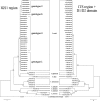Three-locus identification, genotyping, and antifungal susceptibilities of medically important Trichosporon species from China
- PMID: 21900517
- PMCID: PMC3209122
- DOI: 10.1128/JCM.00937-11
Three-locus identification, genotyping, and antifungal susceptibilities of medically important Trichosporon species from China
Abstract
Three reference and 45 clinical isolates of Trichosporon were analyzed by conventional phenotypic and molecular methods to determine the species and genotypes of Trichosporon isolates from China. Target loci for molecular methods included the internal transcribed spacer (ITS) region, the D1/D2 domain of the 26S rRNA gene, and the intergenic spacer 1 (IGS1) region. Identification of eight Trichosporon species was achieved, of which Trichosporon asahii was the most common. Of the sequence-based molecular methods, the one targeting the D1/D2 domain assigned 97.9% (47/48) of isolates (seven species) correctly, while tests targeting both the ITS and IGS1 regions correctly identified all 48 isolates. The commercial API 20C AUX and Vitek 2 Compact YST systems correctly identified 91.9% and 73% of isolates when their biochemical profiles were queried against those of species contained in the databases, respectively, and misidentified 63.6% and 36.4% of isolates of species that were unclaimed by the databases, respectively. The predominant genotype among T. asahii clinical isolates, genotype 4 (51.4%), is rarely found in other countries. Voriconazole and itraconazole were the most active drugs in vitro against all the Trichosporon species tested, while caspofungin and amphotericin B demonstrated poor activity.
Figures

References
-
- Agirbasli H., et al. 2008. Two possible cases of Trichosporon infections in bone-marrow-transplanted children: the first case of T. japonicum isolated from clinical specimens. Jpn. J. Infect. Dis. 61:130–132 - PubMed
-
- Araujo Ribeiro M., Alastruey-Izquierdo A., Gomez-Lopez A., Rodriguez-Tudela J. L., Cuenca-Estrella M. 2008. Molecular identification and susceptibility testing of Trichosporon isolates from a Brazilian hospital. Rev. Iberoam. Micol. 25:221–225 - PubMed
-
- Bassetti M., et al. 2004. Trichosporon asahii infection treated with caspofungin combined with liposomal amphotericin B. J. Antimicrob. Chemother. 54:575–577 - PubMed
-
- Chagas-Neto T. C., Chaves G. M., Melo A. S., Colombo A. L. 2009. Bloodstream infections due to Trichosporon spp.: species distribution, Trichosporon asahii genotypes determined on the basis of ribosomal DNA intergenic spacer 1 sequencing, and antifungal susceptibility testing. J. Clin. Microbiol. 47:1074–1081 - PMC - PubMed
Publication types
MeSH terms
Substances
Associated data
- Actions
- Actions
- Actions
- Actions
- Actions
- Actions
- Actions
- Actions
- Actions
- Actions
- Actions
- Actions
- Actions
- Actions
- Actions
- Actions
- Actions
- Actions
- Actions
- Actions
- Actions
- Actions
- Actions
- Actions
- Actions
- Actions
- Actions
- Actions
- Actions
- Actions
- Actions
- Actions
- Actions
- Actions
- Actions
- Actions
- Actions
- Actions
- Actions
- Actions
- Actions
- Actions
- Actions
- Actions
- Actions
- Actions
- Actions
- Actions
- Actions
- Actions
- Actions
- Actions
- Actions
- Actions
- Actions
- Actions
- Actions
- Actions
- Actions
- Actions
- Actions
- Actions
- Actions
- Actions
- Actions
- Actions
- Actions
- Actions
- Actions
- Actions
- Actions
- Actions
- Actions
- Actions
- Actions
- Actions
- Actions
- Actions
- Actions
- Actions
- Actions
- Actions
- Actions
- Actions
- Actions
- Actions
- Actions
- Actions
- Actions
- Actions
- Actions
- Actions
- Actions
- Actions
- Actions
- Actions
- Actions
- Actions
- Actions
- Actions
- Actions
- Actions
- Actions
- Actions
- Actions
- Actions
- Actions
- Actions
- Actions
- Actions
- Actions
- Actions
LinkOut - more resources
Full Text Sources
Molecular Biology Databases

